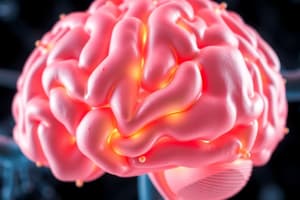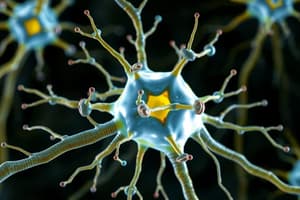Podcast
Questions and Answers
What is the resting membrane potential of a neuron?
What is the resting membrane potential of a neuron?
- -90 mV
- -70 mV (correct)
- 0 mV
- +55 mV
What occurs when a neurotransmitter depolarizes the membrane?
What occurs when a neurotransmitter depolarizes the membrane?
- The cell becomes more negative.
- The sodium channels remain closed.
- The likelihood of an action potential increases. (correct)
- The action potential is inhibited.
What is the primary role of the synapse in neural communication?
What is the primary role of the synapse in neural communication?
- It generates energy for neuronal activity.
- It stores neurotransmitters for future use.
- It is the site where neural communication occurs. (correct)
- It acts as a barrier for ion flow.
What does it mean that action potentials are an all-or-nothing phenomenon?
What does it mean that action potentials are an all-or-nothing phenomenon?
Which phase of the action potential is characterized by a massive reversal of membrane potential?
Which phase of the action potential is characterized by a massive reversal of membrane potential?
What happens to the resting membrane potential if a neuron cannot maintain it?
What happens to the resting membrane potential if a neuron cannot maintain it?
Which ion's movement is primarily responsible for making the inside of the cell more negative?
Which ion's movement is primarily responsible for making the inside of the cell more negative?
Which type of channel opens at the threshold of excitation during an action potential?
Which type of channel opens at the threshold of excitation during an action potential?
What effect does hyperpolarization of the membrane have on neuron firing?
What effect does hyperpolarization of the membrane have on neuron firing?
What is the main function of the sodium-potassium pump?
What is the main function of the sodium-potassium pump?
How does the frequency of firing relate to the intensity of a stimulus?
How does the frequency of firing relate to the intensity of a stimulus?
Which property distinguishes channels from pumps in neuronal communication?
Which property distinguishes channels from pumps in neuronal communication?
Which channel type is always open and contributes to the resting membrane potential?
Which channel type is always open and contributes to the resting membrane potential?
How many sodium ions does the sodium-potassium pump transport out of the cell?
How many sodium ions does the sodium-potassium pump transport out of the cell?
Which of the following is true about potassium 'leak' channels?
Which of the following is true about potassium 'leak' channels?
What is the effect of the sodium-potassium pump's activity on the charge inside the neuron?
What is the effect of the sodium-potassium pump's activity on the charge inside the neuron?
What is the primary function of myelin in axonal conduction?
What is the primary function of myelin in axonal conduction?
What occurs in an unmyelinated axon that affects conduction speed?
What occurs in an unmyelinated axon that affects conduction speed?
Which type of receptor is characterized by having a fast, transient effect?
Which type of receptor is characterized by having a fast, transient effect?
In the context of Multiple Sclerosis, what effect does the disease have on conduction?
In the context of Multiple Sclerosis, what effect does the disease have on conduction?
Which of the following best describes metabotropic receptors?
Which of the following best describes metabotropic receptors?
Which ions are commonly associated with excitatory postsynaptic potentials (EPSPs)?
Which ions are commonly associated with excitatory postsynaptic potentials (EPSPs)?
Where are voltage-gated sodium channels primarily located in a myelinated axon?
Where are voltage-gated sodium channels primarily located in a myelinated axon?
Which neurotransmitter characteristic is associated with inhibitory postsynaptic potentials (IPSPs)?
Which neurotransmitter characteristic is associated with inhibitory postsynaptic potentials (IPSPs)?
What is the primary role of autoreceptors?
What is the primary role of autoreceptors?
Which of the following statements correctly describes heteroreceptors?
Which of the following statements correctly describes heteroreceptors?
Which of the following mechanisms is NOT involved in neurotransmitter cleanup?
Which of the following mechanisms is NOT involved in neurotransmitter cleanup?
What is the purpose of re-uptake in neurotransmitter regulation?
What is the purpose of re-uptake in neurotransmitter regulation?
What is a potential downside of the diffusion process in neurotransmitter cleanup?
What is a potential downside of the diffusion process in neurotransmitter cleanup?
Flashcards are hidden until you start studying
Study Notes
Neural Communication Overview
-
Neurons communicate with each other through the synapse, a specialized junction.
-
Neuronal communication is both electrical and chemical.
-
It relies on the movement of ions, primarily sodium (Na+) and potassium (K+), across the cell membrane.
Resting Membrane Potential
-
A healthy neuron maintains a resting membrane potential between -60 and -80 mV.
-
This is crucial for neuronal function, as it allows for the generation of action potentials.
-
This potential is maintained by the sodium-potassium pump, which actively pumps 3 Na+ ions out of the cell and 2 K+ ions into the cell, creating a net negative charge inside the cell.
-
The resting state is characterized by closed sodium channels, open potassium channels, and continuous activity of the sodium-potassium pump.
Neuronal Communication
-
Cells communicate via channels and pumps embedded within the plasma membrane.
-
Channels: allow passive diffusion of ions, facilitating rapid movement.
-
Pumps: actively transport ions against their concentration gradient, requiring ATP and resulting in slower movement.
Sodium-Potassium Pump
-
It is crucial for maintaining the resting membrane potential, being responsible for ⅔ of all energy utilization in the brain.
-
It helps to establish the concentration gradient of sodium and potassium, with higher sodium concentration outside the cell and higher potassium concentration inside.
-
The pump contributes to the negative charge inside the cell.
Potassium “Leak” Channels
-
They allow potassium to flow out of the cell, contributing to the negative resting membrane potential.
-
These channels are constantly open and do not require energy.
Cell Polarization
-
The resting membrane potential is a balance between chemical and electrical forces.
-
The chemical force pushes potassium out of the cell, while the electrical force pulls potassium in.
Synaptic Transmission
-
Neurotransmitter binding to receptors can have two effects:
- Depolarization: moves the membrane potential towards 0, making the cell less polarized.
- Hyperpolarization: moves the membrane potential further negative, making the cell more polarized.
-
Depolarization: is excitatory and increases the likelihood of an action potential.
-
Hyperpolarization: is inhibitory and decreases the likelihood of an action potential.
-
Postsynaptic potentials (PSPs): travel like electrical signals along non-insulated wires and are graded, rapid, and decremental, meaning they decay over distance.
Action Potential Generation
-
Occurs at the axon initial segment when the membrane depolarizes above the threshold of excitation.
-
It is a massive, brief reversal of the membrane potential from -70 mV to +55 mV.
-
It is an all-or-nothing event, always the same size and shape, but its frequency of firing encodes intensity.
Phases of Action Potential
- Depolarization Phase (Rising Phase): caused by the influx of sodium through voltage-gated sodium channels.
- Repolarization Phase: caused by the efflux of potassium through potassium channels.
- Hyperpolarization Phase: caused by the continued potassium efflux, resulting in a membrane potential below the resting potential.
Proteins Involved in Action Potential
- Voltage-gated Sodium Channels (Nav): open at the threshold of excitation, allowing sodium influx, responsible for the rising phase of the action potential.
- Potassium Channels:
- Leak Channels: always open.
- Voltage-gated Potassium Channels: open during the rising phase, contributing to repolarization and hyperpolarization.
Action Potential Conduction
- Starts at the initial segment and travels down the axon.
- It does not decay but is constantly regenerated.
Conduction in Unmyelinated Axons
-
Conduction speed is limited by the number of voltage-gated sodium channels.
-
There are voltage-gated sodium channels all along the axon.
Myelination
-
Myelin acts as insulation, allowing action potentials to travel faster over longer distances.
-
It reduces the decay of the action potential.
-
Voltage-gated sodium channels are only located at the Nodes of Ranvier, gaps in the myelin sheath.
Multiple Sclerosis (MS)
-
It is a disorder that damages and destroys myelin, impairing signal conduction.
-
Its prevalence is high in Canada, with a significant connection to the Epstein-Barr virus.
Synaptic Receptor Types
-
Ionotropic Receptors:
- Ligand-gated ion channels.
- Excitatory: depolarizing, allowing sodium influx.
- Inhibitory: hyperpolarizing, allowing chloride influx.
- Fast, transient effects.
-
Metabotropic Receptors:
- G-protein coupled receptors.
- Modulatory effects, altering cell metabolism.
- Slow, long-lasting effects, influencing protein formation/production.
Receptor Locations
- Postsynaptic Receptors: typically located on dendrites or the cell body.
- Presynaptic Receptors:
- Autoreceptors: regulate neurotransmitter release, usually inhibitory and metabotropic.
- Heteroreceptors: modulate the activity of other neurons, altering their sensitivity.
Neurotransmitter Clean-up
- Diffusion: neurotransmitters float away from the synapse.
- Enzymatic Degradation: breakdown of neurotransmitters into inactive metabolites.
- Re-uptake: repackaging of neurotransmitters for reuse:
- Presynaptic Re-uptake: specialized transporters re-uptake neurotransmitters into the axon.
- Astrocyte Re-uptake: astrocytes absorb neurotransmitters from the synapse.
Studying That Suits You
Use AI to generate personalized quizzes and flashcards to suit your learning preferences.




